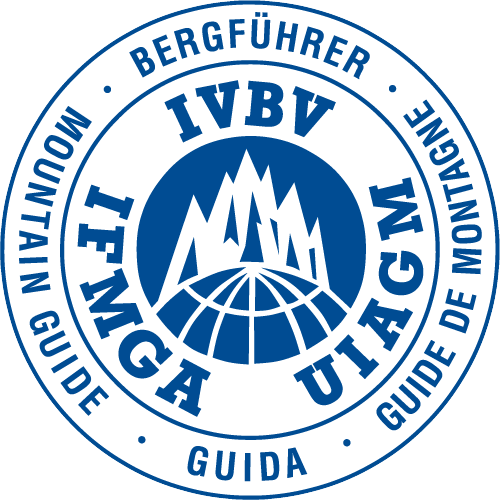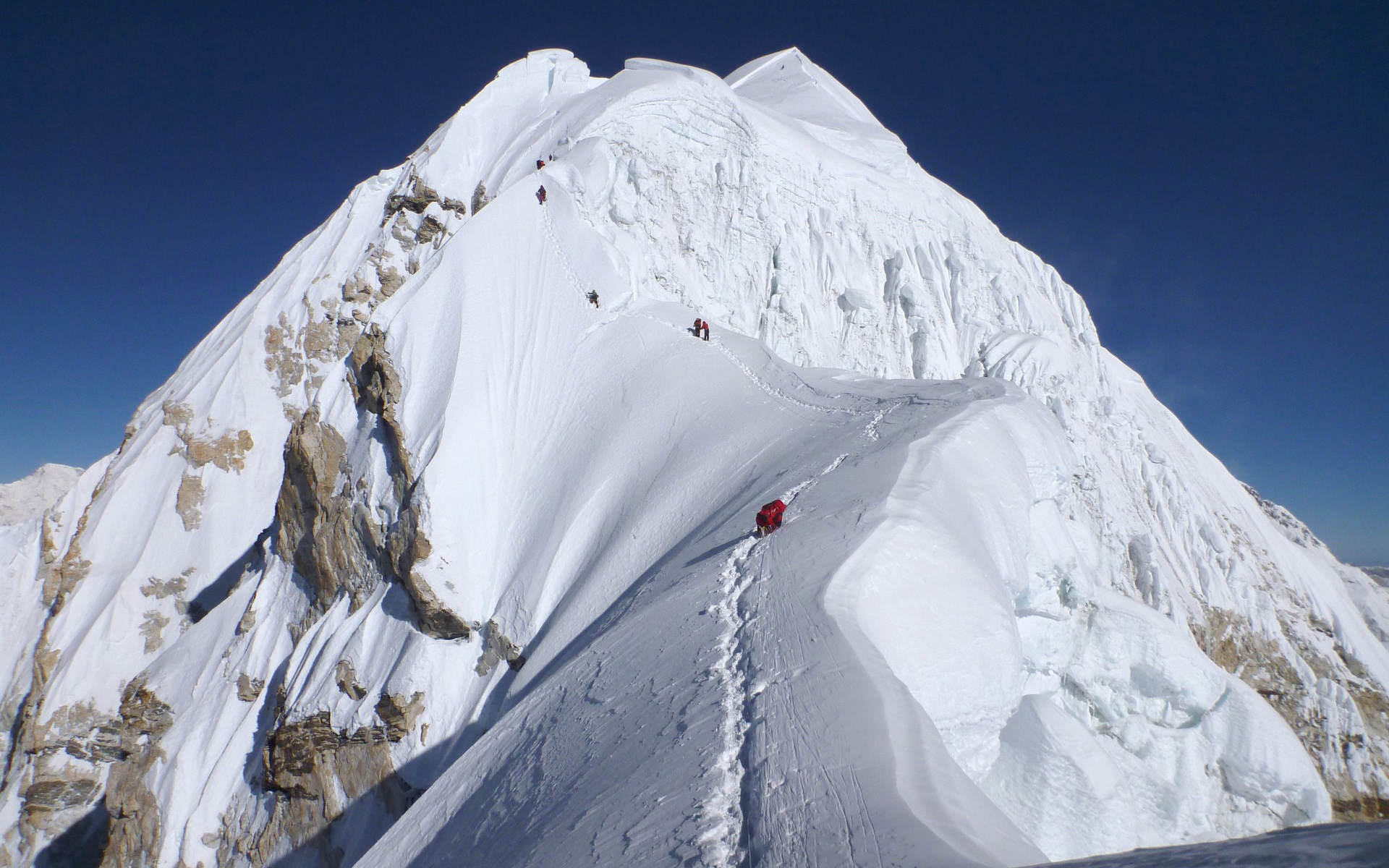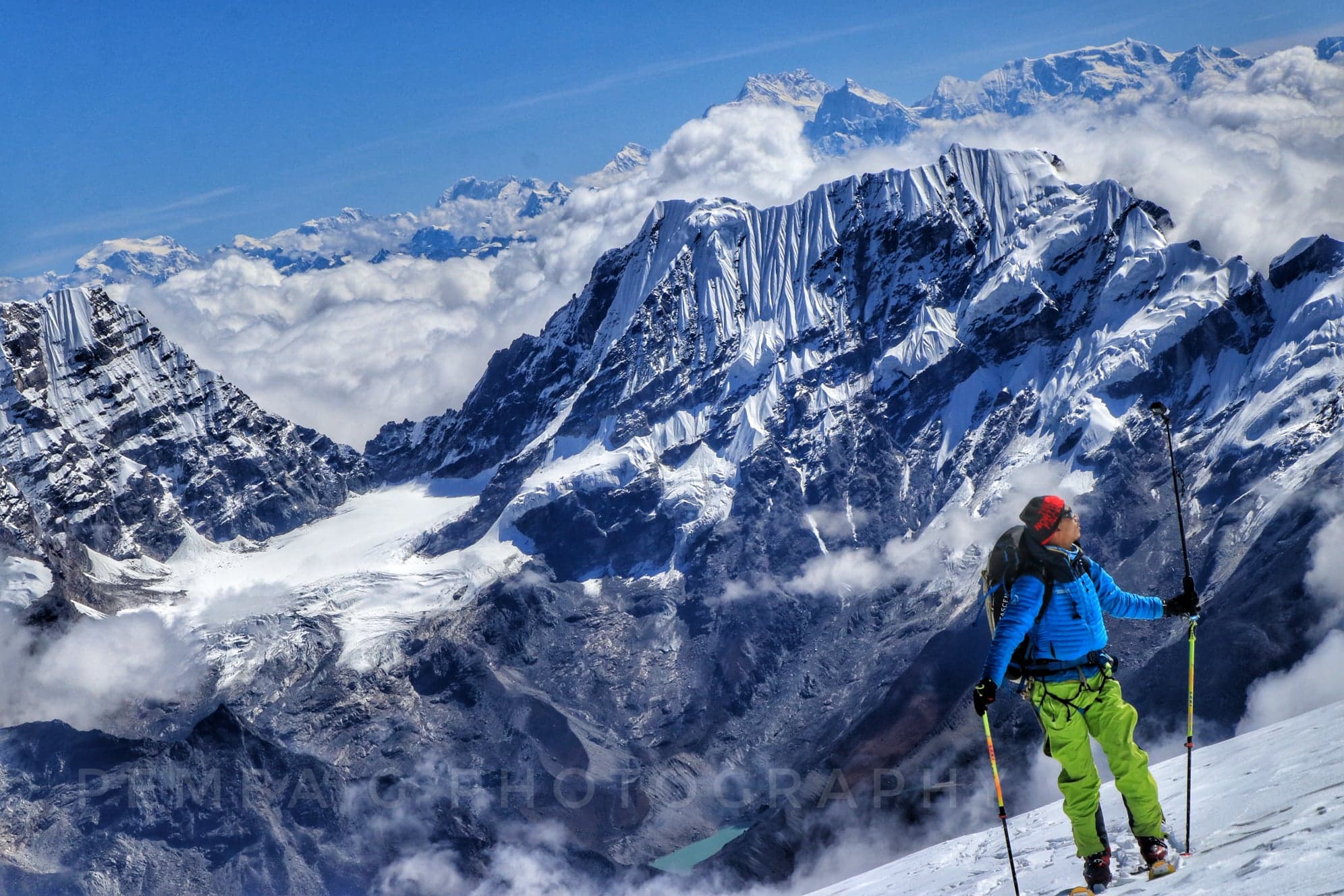

Our team is here to support you 24/7. Please feel free to provide your queries. You will get response within few minutes.




Mt. Baruntse is a mountain in eastern Nepal, crowned by four peaks and bounded on the south by the Hunku Glacier, on the east by the Barun Glacier, and on the northwest by the Imja Glacier.
The peak stands majestically surrounded by some of the world’s highest mountains – Everest, Lhotse, and Makalu to the north and Makalu on the other side.
The climb up to West Col imposes a significant challenge. The summit overall is not so technical but is physically demanding. The mountain was first climbed May 30, 1954, via the south ridge by Colin Todd and Geoff Harrow of a New Zealand expedition.

38 Days Expedition / (SKILL LEVEL: hard)
Day 1: Arrival in Kathmandu
Upon your arrival in Kathmandu, our team will warmly welcome you at the airport and transfer you to your hotel. This day is reserved for you to rest and relax after your flight. You can explore the bustling streets of Thamel or visit nearby landmarks if you feel up to it. In the evening, we will host a welcome dinner where you’ll meet the expedition team and receive an overview of the adventure ahead. Overnight in Kathmandu.
Day 2: Preparation Day in Kathmandu
Today is a preparation day dedicated to organizing your equipment and ensuring all necessary permits and paperwork are in order. This day allows you to check your gear, purchase any last-minute items, and take time to relax before heading into the mountains. You can also use this time to explore some of Kathmandu’s cultural treasures, including temples, stupas, and markets. Overnight at the hotel in Kathmandu.
Day 3: Expedition Briefing at the Ministry of Tourism
In the morning, we will attend a mandatory expedition briefing at the Ministry of Tourism, where we’ll finalize permits and receive official approval for the climb. This is an important step in ensuring the safety and success of the expedition. Afterward, you can enjoy the rest of the day at your leisure, exploring more of Kathmandu or relaxing before the big journey. Overnight at the hotel in Kathmandu.
Day 4: Fly to Lukla (2,820m) and Trek to Paiya (2,730m) – 3-4 hrs
We begin the expedition with a scenic flight from Kathmandu to Lukla, the gateway to the Khumbu region. Upon landing, we meet the rest of the trekking crew and start our trek to Paiya (Chutok). The trail takes us through lush forests and charming Sherpa villages, offering a great introduction to the landscape and culture of the region. We’ll settle in Paiya for the night, enjoying the tranquil surroundings and preparing for the journey ahead.
Day 5: Paiya to Pangoma (2,850m) – 5-6 hrs
Today’s trek takes us from Paiya to Pangoma, passing through forested trails, suspension bridges, and terraced fields. The path gradually ascends, offering beautiful views of the surrounding hills and valleys. Pangoma is a traditional Sherpa village, where we’ll experience the rich culture and warm hospitality of the locals. Overnight in Pangoma, with time to relax and soak in the peaceful mountain atmosphere.
Day 6: Pangoma to Nigmsaw (2,745m) – 4-5 hrs
We leave Pangoma behind and trek toward Nigmsaw, a scenic trail that takes us through rhododendron forests and alpine meadows. The day involves moderate trekking, with some ups and downs along the way. As we climb higher, the landscape becomes more rugged and dramatic. Nigmsaw is a small, peaceful settlement where we’ll rest for the night, preparing for more challenging terrain ahead.
Day 7: Nigmsaw to Chhatra Khola (3,150m) – 7-8 hrs
Today is a longer day of trekking as we make our way from Nigmsaw to Chhatra Khola. The trail winds through dense forests and crosses high ridges, offering panoramic views of the surrounding peaks. We’ll encounter fewer villages as we move deeper into the remote wilderness. The day is physically demanding but rewarding, with stunning landscapes and a sense of adventure. Overnight in Chhatra Khola.
Day 8: Chhatra Khola to Kote (3,600m) – 6-7 hrs
We continue our trek toward Kote, following the trail along the Hinku River. The route becomes more rugged, and we’ll notice a change in the landscape as we gain elevation. The towering peaks of the Himalayas come into full view, inspiring awe as we approach the higher altitudes. Kote is a small settlement nestled in the Hinku Valley, where we’ll spend the night.
Day 9: Kote to Thangnak (4,356m) – 5 hrs
Today’s trek takes us higher into the Hinku Valley as we make our way to Thangnak. The path leads through rocky terrain, with views of massive glaciers and towering peaks. As we gain altitude, you’ll notice the air getting thinner, and we’ll take it slow to allow for proper acclimatization. Thangnak is a picturesque village situated beneath towering mountains, offering breathtaking views. Overnight in Thangnak.
Day 10: Thangnak to Khare (5,045m) – 4-5 hrs
We leave Thangnak and make our way to Khare, the base for our Mera Peak ascent. The trail becomes steeper and more challenging as we climb higher. Along the way, we’ll pass beautiful glacial lakes and enjoy unobstructed views of the surrounding peaks. Khare is a small camp nestled in the heart of the mountains, where we’ll rest and prepare for the upcoming summit. Overnight in Khare.
Day 11: Acclimatization Day in Khare / Preparation Day
Today is dedicated to acclimatization and preparation for the high-altitude climb ahead. We’ll take a short hike to higher elevations and return to camp, allowing our bodies to adjust to the thin air. This is also a good opportunity to go over our gear and ensure everything is for the summit push. Overnight in Khare, with time to relax and prepare for the challenge ahead.
Day 12: Khare to Mera La (5,415m) to Base Camp (5,350m) – 3-4 hrs
We begin the day with a challenging climb to Mera La, the pass that leads to Mera Peak. The trail is steep and snowy, requiring careful navigation. From Mera La, we descend slightly to our base camp, where we’ll set up for the night. The views from camp are spectacular, with Mera Peak looming above and other towering peaks surrounding us. Overnight at Mera Peak Base Camp.
Day 13: Base Camp to High Camp (5,780m) – 4 hrs
Today we make the climb to High Camp, the final stop before the summit of Mera Peak. The ascent is steep and challenging, with breathtaking views of the surrounding glaciers and mountains. As we reach High Camp, we’ll prepare for the early morning summit push. The sense of excitement and anticipation builds as we rest and ready ourselves for the final climb. Overnight at High Camp.
Day 14: Mera High Camp to Summit (6,476m) to Kongma Dingma (4,850m) – 9-10 hrs.
We rise early for the summit push, navigating through snow and ice as we climb toward the peak of Mera. Reaching the summit is a moment of triumph, with panoramic views of the Himalayas, including Everest, Makalu, and Kanchenjunga. After celebrating at the top, we descend to Kongma Dingma, a long and rewarding day of adventure. Overnight in Kongma Dingma.
Day 15: Reserve Day (in case of bad weather or acclimatization problems)
This day is set aside as a reserve day in case of bad weather or acclimatization problems. If everything goes according to plan, we’ll use this day to rest and recover from the summit climb, enjoying the peaceful surroundings of Kongma Dingma.
Day 16: Kongma Dingma to Seto Pokhari (5,035m) – 6 hrs
Today we continue our trek through the remote and rugged terrain of the Hinku Valley, making our way to Seto Pokhari. The trail offers stunning views of the surrounding peaks and glaciers, with few signs of human habitation. Seto Pokhari is a tranquil glacial lake surrounded by towering mountains, offering a serene setting for the night.
Day 17: Seto Pokhari to Baruntse Base Camp (5,250m) – 6 hrs
We trek from Seto Pokhari to Baruntse Base Camp, following a challenging but rewarding route through high-altitude terrain. The base camp is located at the foot of Baruntse, a stunning peak that we will attempt to climb in the coming days. Overnight at Baruntse Base Camp, where we’ll prepare for the climbing period ahead.
Days 18-28: Baruntse Climbing Period
The next several days are dedicated to the ascent of Baruntse, a challenging 7,129-meter peak in the heart of the Himalayas. The climb involves technical sections, including ice and rock, and requires careful acclimatization and teamwork. Our experienced guides will lead the way, ensuring a safe and successful ascent. After reaching the summit, we’ll descend back to base camp to celebrate the accomplishment.
Day 29: Pack and Clean Up at Baruntse Base Camp
After the successful climb of Baruntse, we take the day to pack up our gear and clean the base camp area. Our team will ensure that we leave no trace behind, maintaining the pristine environment of the mountains. Once everything is packed and ready, we’ll rest and prepare for the next phase of the trek.
Day 30: Baruntse Base Camp to Amphu Labsta Base Camp (5,650m) – 4-5 hrs
We continue our adventure by trekking toward the Amphu Labsta Pass. Today’s journey takes us to the southern base camp of Amphu Labsta, a high mountain pass that connects the Hinku Valley with the Imja Valley. The trail is steep and challenging, but the views are extraordinary. Overnight at Amphu Labsta Base Camp.
Day 31: Amphu Labsta Base Camp (South) to Amphu Labsta Base Camp (North) (5,300m) – 5-6 hrs
We cross the Amphu Labsta Pass today, a thrilling and demanding section of the trek. The pass reaches an elevation of 5,780 meters and requires technical climbing skills to navigate. Once we reach the north side of the pass, we’ll descend to the northern base camp, where we’ll rest for the night after a challenging but exhilarating day.
Day 32: Cross the Amphu Labsta Pass (5,780m) and Descend to Imja Valley – 10 hrs
We start early today to cross the Amphu Labsta Pass, a demanding and technical section of the trek. The climb is steep and requires the use of ropes and crampons, but the views from the top are unparalleled. After crossing the pass, we descend into the Imja Valley, a beautiful and remote area surrounded by towering peaks. Overnight in the valley after a long day of trekking.
Day 33: Amphu Labsta Base Camp to Pangboche (3,930m) – 6-7 hrs
We continue our descent into the Imja Valley, making our way to the Sherpa village of Pangboche. The trail takes us through alpine meadows and past ancient monasteries, offering a glimpse into the rich cultural heritage of the Khumbu region. Pangboche is a traditional village known for its monastery and stunning views of Ama Dablam. Overnight in Pangboche.
Day 34: Pangboche to Namche Bazaar (3,440m) – 5-6 hrs
Today’s trek takes us back to Namche Bazaar, the bustling hub of the Khumbu region. The trail follows the Dudh Koshi River, passing through Sherpa villages and rhododendron forests. Namche is a great place to relax after several weeks in the mountains, with plenty of shops, cafes, and lodges. Overnight in Namche Bazaar.
Day 35: Namche Bazaar to Lukla (2,800m) – 6-7 hrs
Our final day of trekking takes us from Namche Bazaar to Lukla, where we’ll catch our flight back to Kathmandu. The trail descends through forests and crosses suspension bridges, offering beautiful views of the valley below. Once in Lukla, we’ll celebrate the successful completion of the trek with a farewell dinner. Overnight in Lukla.
Day 36: Fly from Lukla to Kathmandu
We take an early morning flight from Lukla to Kathmandu, enjoying one last view of the towering peaks of the Himalayas. Upon arrival in Kathmandu, you’ll be transferred to your hotel for a well-deserved rest. The remainder of the day is free for you to relax, shop for souvenirs, or explore the city. Overnight in Kathmandu.
Day 37: Free Day in Kathmandu
Today is a free day in Kathmandu, allowing you to explore more of the city’s cultural and historical landmarks or simply relax after your expedition. You can visit temples, monasteries, and markets, or unwind at your hotel. In the evening, we’ll gather for a farewell dinner to celebrate the successful completion of the expedition. Overnight in Kathmandu.
Day 38: Departure from Kathmandu
After an incredible adventure in the Himalayas, it’s time to say goodbye. You’ll be transferred to the airport for your international departure. We hope you leave with unforgettable memories and the sense of accomplishment from summiting Mera Peak and Baruntse. Safe travels!